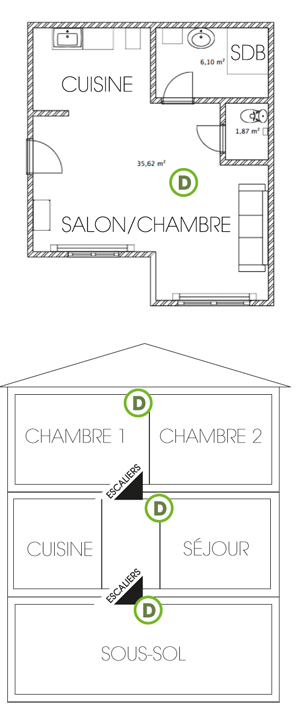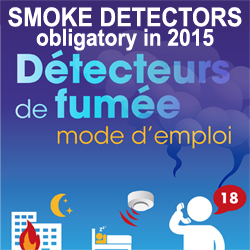 We have had a smoke detector in our suburban Paris home for many years – it seems “normal” to me, but I realized how unusual its actually was when my housekeeper reported a mouse sound coming from the landing one day while we were on a trip. Thinking that we probably didn’t have mice, but not wanting this sound to go without investigation I asked a neighbor to stop by. They couldn’t figure it out. The next week my housekeeper saw nothing new and yet heard the peep again. I was quite perplexed, but since there were no other signs I did not pursue the matter. Upon arriving at home and going upstairs I immediately heard the beep of the the smoke detector reminding us to change an expiring battery. A few mintues later I burst out laughing as I realized that the smoke detector was the mouse. The incident made me realize that smoke detectors were not very common.
We have had a smoke detector in our suburban Paris home for many years – it seems “normal” to me, but I realized how unusual its actually was when my housekeeper reported a mouse sound coming from the landing one day while we were on a trip. Thinking that we probably didn’t have mice, but not wanting this sound to go without investigation I asked a neighbor to stop by. They couldn’t figure it out. The next week my housekeeper saw nothing new and yet heard the peep again. I was quite perplexed, but since there were no other signs I did not pursue the matter. Upon arriving at home and going upstairs I immediately heard the beep of the the smoke detector reminding us to change an expiring battery. A few mintues later I burst out laughing as I realized that the smoke detector was the mouse. The incident made me realize that smoke detectors were not very common.
In fact, in France only two percent of homes are fitted with detectors as opposed to 97 percent in Norway and 88 percent in England. The majority of states in the U.S. have laws since 2010 or before making smoke detectors and carbon monoxide detectors mandatory in private homes and now France is about to take that step.
It has been estimated that if smoke detectors were installed in 80 percent of homes in France the mortality rate from fires would be halved. In France, a fire breaks out every two minutes, causing 800 deaths a year. Seventy percent of those fires occur at night; most deaths are caused by smoke inhalation and two-thirds of the victims die in their sleep. If a property is protected with a smoke alarm the occupant would theoretically be alerted before the fire took hold. As a result of those findings the Ministry of Housing, the Ministry of the Interior and the Ministry of Ecology, Sustainable Development and Energy passed a law in 2010 requiring all households to be fitted with smoke detectors by March 2015. The date is just around the corner.
The directive from the Ministries includes the following information:
Dectectors must be installed in all housing: primary, secondary, vacation, rental, old, new, private or public… A smoke detector should, preferably, be installed in a corridor or hallway leading to bedrooms; the sensor should be secured on the ceiling or at the top of a wall, away from a direct source of smoke or steam (kitchen or bathroom). The onus is on the occupant to install a detector. But in the case of a vacation rental or furnished rental it is the owner who is required to install a detector. The occupant, the owner or agency managing a property must regularly check the sensor has power and carrying out tests (accredited detectors are fitted with a small ‘test’ button for this purpose). It is a good idea to plan to test the detector for example every first of the month or each time you get the telephone bill – just to make it part of the routine. The unit cost for a detector is about 20 euros.
 Some consumer magazines warn that not all DAAFs (Détecteur Autonome Avertisseur de Fumée) are created equally and many do not meet standards. To avoid the use of smoke detectors that do not conform with EU standards the following requirements should be observed:
Some consumer magazines warn that not all DAAFs (Détecteur Autonome Avertisseur de Fumée) are created equally and many do not meet standards. To avoid the use of smoke detectors that do not conform with EU standards the following requirements should be observed:
- The unit should be marked with the CE notation or better yet EN 14 604 which is the European norm
- A power indicator must be included
- The unit should be powered by batteries, with a minimum operating time of one year, or include AC-power cable.
- The unit must emit a visual or audible signal, indicating the absence of batteries or low batteries. The error signal must be different than the alarm signal.
- In case of smoke detection, the unit must emit an alarm signal to a noise level of at least 85 dB (A) audible at 3 metres.
- The following information must be indelibly marked on the unit: the brand name, address of the manufacturer or supplier number, date of the standard that the detector complies with, manufacturing date or batch number and type of battery to use.
- The unit should be supplied with instructions for installation, maintenance and control of the sensor and the model certificate that the occupant must provide an insurer in case of a claim for damage caused by fire.
- Be sure to get a détecteur de fumée ou DAAF (Détecteur Autonome Avertisseur de Fumée) and not a détecteur de monoxyde de carbone, they look alike and are usually displayed together, but are not the same.
More information can be found in French in the pamphlet “Detecteurs de Fumée: mode d’emploi” which can be downloaded here. 
A note about insurance. Once the detector is installed report it to your insurance company. You may benefit from a reduction. On the other hand if either the declaration of detector installation has not been made or a detector has not been installed the insurance company can impose a high deductible (up to 5000€) in case of damage due to fire. They cannot however go so far as to refuse a claim all together.
In case of fire the following recommendations are given by the French Ministry of Housing:
Call the firefighters (pompiers) on 18 or 112.
- Never enter a room where there is smoke.
- If you are in a room where there is smoke, cover your mouth and nose with a handkerchief or cloth, stay close to the floor; fresh air will be closer to the floor as heat and smoke rise.
- Never take the elevator, take the stairs.
If a fire starts in your home and you cannot put it out immediately:
- Evacuate;
- Close the door of your home to avoid wind currents that will fan the fire;
- Leave through the nearest exit.
If the fire is at or below your level and you cannot safely exit:
- Stay home
- Close the door of your apartment and wet the floor and area around the door;
- Stand in front of a window so that firefighters can see you.
If the fire is above you leave through the nearest exit.


